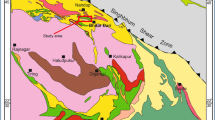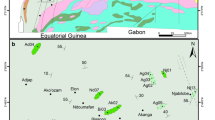Abstract
The Reguibat Shield of North Mauritania represents the northern exposure of the West African Craton. Mesoarchean rocks of the Aoueouat greenstone belt host the Tasiast gold deposits. This work focus on mineralogical, petrographic, and geochemical studies of some samples collected from two drillings cores (05213DD and 05214DD) from the West Branch Pit linked to the shear zone and hosted in the greenstone belt “Aoueouat” at Tasiast mine in Mauritania. Diorite, felsite, greywacke, and siltstone represent the studied rock samples. These rocks are the seat of abundant silicate mineral and carbonate neoformations, reflecting mineralized flows. The petrography (observations), mineralogy (XRD), and geochemistry (XRF) were conducted in order to understand the process that controls the mineralization and the mineralogical phases. All these analyses allowed us to derive that the highest gold concentrations are hosted in the dioritic rock unit, within the creamy sulfide layer (pyrrhotite and pyrite) and the quartz veins. The observed minerals indicating metamorphism are amphiboles, micas, and neoformed minerals, such as chlorite and fuchsite, which generally crystallized in the hydrothermal veins. These observations reveal that this mineralization was related to the hydrothermal process.
Access provided by Autonomous University of Puebla. Download conference paper PDF
Similar content being viewed by others
Keywords
- Tasiast mine
- West Branch pit
- Orogenic gold
- Greenstone belt
- Magmatic rocks
- Metamorphic rocks
- Neoformed minerals
- Hydrothermal activity
- BIF
1 Introduction
Mauritania is located in West Africa belonging to the West African Craton composed of Archaean formations >2.5 Ga (Maurin et al. 1996). These formations are cropping out in the Reguibat Shield area (part of the four significant geological assemblages of Mauritania, Fig. 2). It contains a greenstone belt of primary economic importance around the world. These rocks contain different resources, including gold deposits. The greenstone belts of Reguibat Shield was considerably explored. In recent years, gold has been the focus, especially in the Tasiast greenstone belts. Normandy Source NLSD (1996–2001) made the most important discovery in the Tasiast deposit, with a very high economic potential. This sector is located in Aoueouat greenstones belts where anomalies of gold were recorded over a length of about 20 km, which divided it into two sectors Piment and West Branch Pit. The latter has been operating in an open-pit mine for several years. Based on pit mapping (Fig. 3), the different lithostratigraphic units are greywacke (SGW), bent iron formations (BIF), siltstone (SVC), felsite (FVC), and granodiorite (GDI). Repetition of folds is evident in sediment intrusion. Much of this volcano-sedimentary ensemble, and this intrusion falls moderately (−40°) toward the east. The host sequence is cut with a set of younger post-mineralization mafic dykes. This volcano-sedimentary assembly is divided by a sub-parallel NNE-SSW shear direction (Figs. 1, 2 and 3).
Geological map of the main geological assemblages of Mauritania (After BGS 2004)
Section showing the different lithological units in West Branch (Isselmou Eghlmbitt et al. 2018)
This study aims to understand better the mechanisms of emplacement and genesis of gold mineralization in the geodynamic and structural framework using mineralogy, petrography, and geochemical data of samples from two mining drillings located in the West Branch pit Aoueouat greenstones belts.
2 Materials and Methods
More than 40 samples were collected from the two drilled cores. Thin sections and polished sections were made for determination of both mineralogy and texture of the rocks through the optical microscope and the metallographic microscope to observe the phases carrying the mineralization. The different samples studied were crushed and analyzed by X-ray diffraction (XRD: 30 mA, 40 kV, Cu Kα). This analysis aims to determine the nature of minerals and establish the mineralogical association of the rocks studied. X-ray fluorescence (XRF) chemical analysis was done in order to determine the major and trace elements content of the sample.
3 Results
The petrography (microscopic observations), mineralogy (XRD), and geochemistry (XRF for major and trace elements) studies were made in order to understand the conditions of implementation of the mineralization and the carrier phases. The XRD analysis reveals the presence, along the two holes, of some minerals like quartz, biotite, chlorite, muscovite, garnet, K-feldspar, amphibole, tourmaline, fuchsite, and cummingtonite whose associations depend on the type of the crossed facies. Results of the geochemical analysis show a high amount of SiO2 (31–67%) associated with Al2O3 ranging from (1.3–20.5) with high percentages of Fe2O3 (0.5–48%) and lower percentages of CaO, MgO, and K2O. The trace elements showed gold grades that vary from (1.3–7 ppm) and sulfur (pyrite and pyrrhotite) with values ranging from (0–265000 ppm). The results obtained from these different types of analysis allowed us to derive the following effects. Microscopic observations and X-ray diffractions analysis confirmed by a chemical analysis allowed us to determine the mineral parageneses made of quartz, feldspar, micas, amphiboles, garnets, oxides, and sulfide associated with gold. The various types of rocks encountered are magmatic rocks (diorite and felsite) and sedimentary rocks (siltstone, greywacke and BIF) which have undergone Catazonal metamorphism. The results of different analyses of the samples show that the dioritic rocks account most of the gold mineralization in addition to the quartz veins with the presence of sulfide minerals.

a-b: Photomicrographs of thin sections showing biotite (Bt), quartz (Qz), feldspar (Fsp), amphibole (Hbl), and garnet (Grt) in dioritic rocks.
c-d: Photomicrographs showing pyrite (Py) and gold (Au).
4 Discussion and Conclusion
The Archean Reguibat Shield is characterized by the presence of an old basement formed of gneiss, granitoids, and greenstone belts. For tectonic, ancient granitc-gneiss formations are characterized by early deformation of folds followed by a diapiric tectonic responsible for the establishment of structure type “mantled gneiss dome.” This tectonic evolution is accompanied with a catazonal metamorphism evolving in the amphibolite facies. The Aoueouat formations are affected by a deformation that shows a gradual evolution with the opening of a sedimentary basin in first extensive episode during which the sedimentary units of Tasiast are deposited (Krus and Geo 2013). This basin reversed after a second compressive episode during the highest degree of metamorphism. The examined gold mineralization is hosted in the dioritic rocks with high content of sulfides and the quartz veins in a sequence of metamorphic mineral, with generally intense foliation defined by the presence of micas, amphiboles, and minerals neoformed, as chlorite and fuchsite that generally meet in the hydrothermal veins. Gold mineralization may be the result of a hydrothermal process associated with the circulation of hydrothermal fluids guided by structures acquired during major regional deformation.
This study has allowed us to derive important results, however, do not allow us to draw general conclusions because the number of drillings and sampling could not confirm or affirm these results. We focused to generate results that enable the discovery of the phenome that controls the mineralization, to determine the continuity of the rock carrying mineralization and their direction, and to understand where we can find another deposit of gold in this region which may have the same properties.
References
BGS: notice Explicative des Cartes Géologiques et Métallogéniques à 1/200 000 et 1/500 000 au Sud de la Mauritanie; Volume I—Géologie; Rapport final du PRISM, British geological survey, 580 p (2004)
Isselmou Eghlembit, Seyidna, A.L., Valentine: TASIAST from West branch to Piment geological mapping, pp. 3–8 (2018)
Key, R.M., Loughlin, S.C., Gillespie, M., Del Rio, M., Horstwood, M.S.A., Crowley, Q.G., Darbyshire, D.P.F., Pitfield, P.E.J., Henney: Two Mesoarchean terranes in the Reguibat shield of NW Mauritania: Geol. Soc. Lond. Spec. Pub. 297, 33–52 P.J (2008)
Krus, S. Ph.D., Geo, P.: Terrane geosciences Inc—regional geometry and tectonic evolution of the Aoueouat greenstone belt and Tasiast metallogenic district for Tasiast Mauritanie limited S.A (2013)
Leroux, D.C., Roy, W.D., Orava, D.: Technical report on the Tasiast gold project, Islamic Republic of Mauritania, unpublished 43–101 report for red back mining Inc., 97 p. (2007)
Maurin, G., Bronner, G., Le Goff, E., and Chardon, D.: Châmi—notice explicative de la carte géologique à 1: 200,000; République Islamique de Mauritanie, Projet FED no. 7 ACP MAU 009 (MAU 7002), Prospection aurifère dans le Tasiast—Tijirit, N2459 (1996)
Normandy la source Mauritanie, Permis Tasiast, Tasiast Sud, N’Daouas, KattAtoui: Recherche d’anomalies aurifères et contrôle par sondage, Avancement des travaux Phase 5 (2000–2001). BRGM/RP-50941-FR—LaSource R00379 location (2000–2001) (2001)
Author information
Authors and Affiliations
Editor information
Editors and Affiliations
Rights and permissions
Copyright information
© 2022 The Author(s), under exclusive license to Springer Nature Switzerland AG
About this paper
Cite this paper
Zeine, M. et al. (2022). Mineralogy, Petrography, and Geochemical Studies of the Greenstone Belt Rocks and the Associated Gold Mineralization of Aoueouat at Tasiast Mine, Mauritania. In: Çiner, A., et al. Recent Research on Geomorphology, Sedimentology, Marine Geosciences and Geochemistry. CAJG 2019. Advances in Science, Technology & Innovation. Springer, Cham. https://doi.org/10.1007/978-3-030-72547-1_75
Download citation
DOI: https://doi.org/10.1007/978-3-030-72547-1_75
Published:
Publisher Name: Springer, Cham
Print ISBN: 978-3-030-72546-4
Online ISBN: 978-3-030-72547-1
eBook Packages: Earth and Environmental ScienceEarth and Environmental Science (R0)







